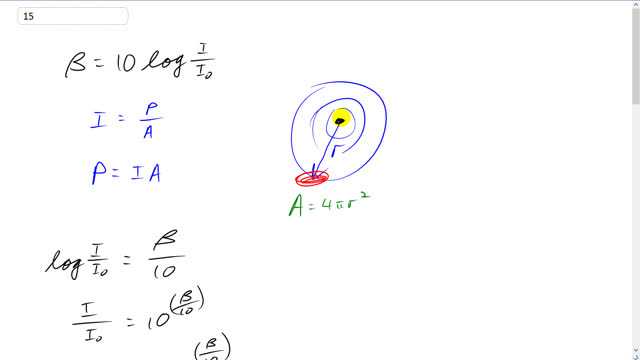
At a rock concert, a dB meter registered 130 dB when placed 2.5 m in front of a loudspeaker on stage.
- What was the power output of the speaker, assuming uniform spherical spreading of the sound and neglecting absorption in the air?
- How far away would the sound level be 85 dB?

In order to watch this solution you need to have a subscription.
This is Giancoli Answers with Mr. Dychko. So, our job is to figure out the power output of the speaker knowing what the sound level is measured at a particular distance, r, from the source of the sound. And we're assuming that the sound source, the speaker, is radiating its sound uniformly radially outwards in a sphere so that the power is evenly distributed over this entire sphere. And the power divided by the area of the sphere, the surface area I should say, is going to be the intensity. And we can we can rearrange this intensity formula, power divided by area, by multiplying both sides by area and getting a power here. And so this is how we calculate the power the speaker where we take intensity and multiply it by area. But we need to use this sound level reading β in decibels in order to calculate what this intensity is. So, we'll do some work with that sound level formula to solve for I and then substitute that into this power equation and then we'll have our answer. So, we'll divide both sides of this black formula by 10 and we get log intensity over reference intensity or threshold of hearing equals β over 10. And make both sides exponents for 10. And on the left side it works out to I over I naught. On the right side, we have 10 to the power of β over 10. And multiply both sides by I naught and you get I equals I naught times 10 to the power of β over 10. So, the power then is I, which is this, I naught times 10 to the power of β over 10 multiplied by the surface area of the sphere over which this power is distributed and that's going to be 4π times the distance from the speaker's squared, 4π r squared. And then we plug in numbers. And we have 1.0 times 10 to the minus 12 watts per square meter times 10 to the power of 130 decibels over 10 multiplied by 4π times 2.5 squared. And this gives about 790 watts is the power output of the speaker. And then the next question is, at what distance would you have to be in order that the sound level is only 85 decibels instead of 130. So, we write that formula down again. And we can substitute for I here in terms of power and area because we know what the power is already we just calculated it in part a. And we know the area is 4π distance from the speaker squared. And that means we'll have a formula here now that contains the only unknown being r. And so we'll do some work to solve for it. So, we'll switch the sides around and divide both sides by 10. And you get log of power over 4π r squared I naught equals β over 10. This p over 4π r squared over I naught. This fraction can be rewritten this way instead too, a little cleaner like this. And then make both sides powers of 10. And then on the left side you have p over 4π r squared I naught. On the right side you have 10 to the power of β over 10. And then we'll solve for r squared by multiplying both sides by r squared and dividing both sides by 10 to the power of β over 10. And on the left side the r squared's cancel leaving us with 10 to the power of β over 10 on the bottom. And on the right side this 10 to the power stuff cancels and we're left with r squared and then I'm switching the sides around as well so that we have r squared alone on one side and we have p over 4π I naught 10 to the power of β over 10 on the other side. And then take the square root of both sides to find r. So, r is a square root of the power output of the speaker divided by 4π reference intensity times 10 to the power of β over 10. So, we plug all the stuff in now. The power output of the speaker is 785.398 watts. And we'll divide that by 4π times 1.0 times 10 to the minus 12 watts per meter squared threshold of hearing intensity level, I naught, times 10 to the power of 85 over 10. And this works out to about 440 meters is the distance you'd have to be from the speaker outputting 785 watts to have a sound level of 85 decibels.
What is your rationale for deciding to multiply by (r^2/10^beta/10) in part B?
Hi margolinw, I think you're referring to the algebra step at 3:36, right? Multiplying by is a way to isolate the unknown by itself on one side of the equation. Multiplying by cancels it on the left side, whereas dividing by cancels that term on the right side, and this results in by itself on the right side. Mission accomplished! Then I switched the sides around and took the square root of .
Hope that helps,
Mr. Dychko